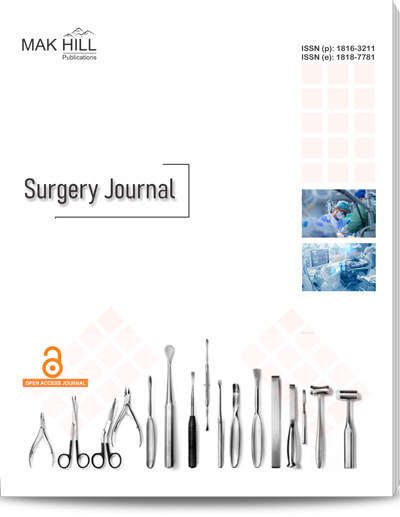
Surgery Journal
ISSN: Online 1818-7781ISSN: Print 1816-3211
Abstract
This study investigated the presentation and progression of appendicular mass cases. In this study, the majority of patients were aged between 31-40 years, with a mean age of 36.2 years, and 60% were female. Most patients (86.7%) experienced diffuse abdominal pain, and 93.3% had right iliac fossa (RIF) pain. Additional symptoms included pain radiating to the RIF in 83.3% of cases, nausea and vomiting in 56.7%, and fever in 40%. This study assessed the duration of acute appendicitis, with an average illness duration of 1.7 days. Initially, 100% of cases presented with an appendicular mass and 96.7% with dilated appendicitis. Clinical signs included RIF tenderness in 96.7% of cases and positive Rovsing, psoas, and obturator signs in over 80% of cases. Over time, these symptoms significantly decreased, with no cases showing dilated appendix, RIF tenderness, Appendicular mass by 12 months with the conservative approach. The conservative management through the OS regimen was successful in 93.3% of cases, while 6.7% required interval appendectomy. Recurrence of appendicitis was observed in 3.6% of patients during a one-year follow-up. This study strongly supports conservative management for appendicular mass, citing a success rate of 93.3% with only 6.7% requiring further surgical intervention. The low recurrence rate of 3.6% over a one-year follow-up period further validates the effectiveness of this approach. Conservative treatment reduces immediate surgical risks, hospital stays, and overall healthcare costs. These findings suggest that with careful monitoring and follow-up, conservative management can be a highly effective and preferable option for patients with Appendicular Mass
How to cite this article:
A. Ramadevi, G.V. Prakash, N.V. Harish, V. Mahidhar Reddy, Patchipala Priya Nandan, A. Nagamani Nikhila and N.S. Prashanth. A Clinical Study on Appendicular Mass and ITS Outcome.
DOI: https://doi.org/10.36478/10.36478/maksj.2024.1.6.19
URL: https://www.makhillpublications.co/view-article/1816-3211/10.36478/maksj.2024.1.6.19